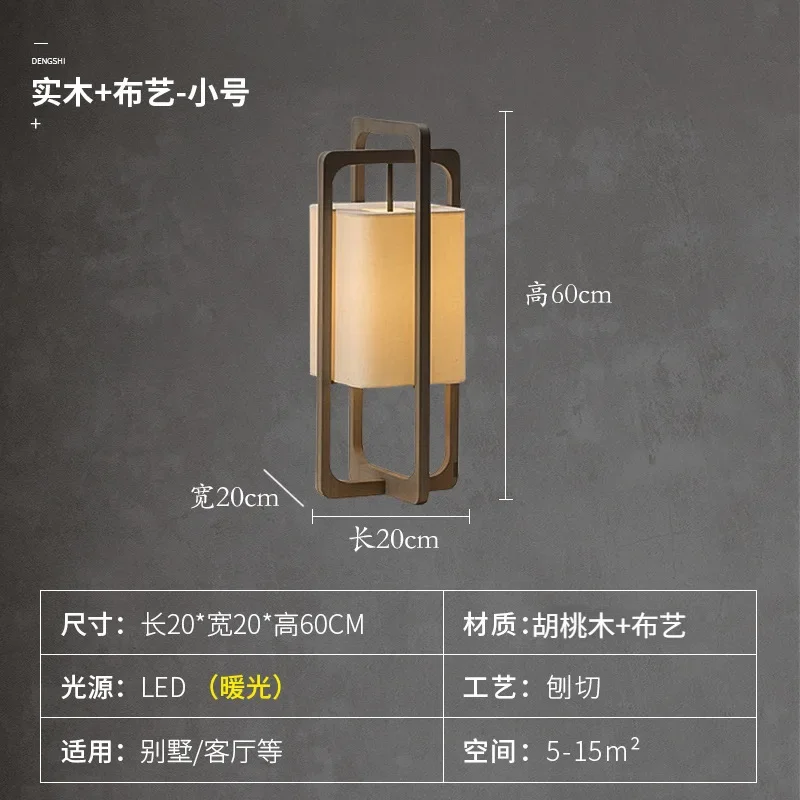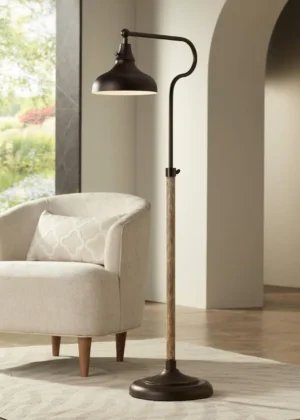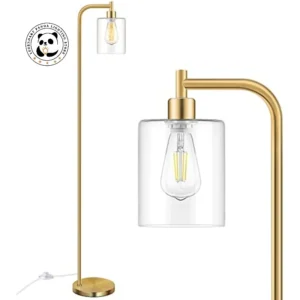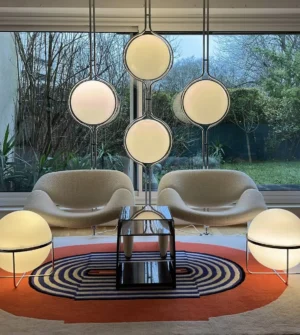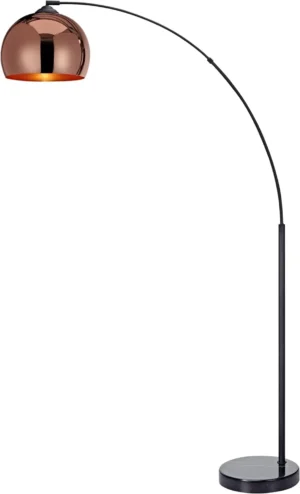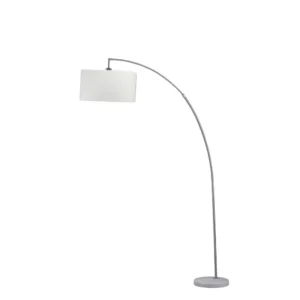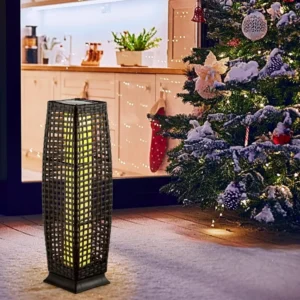Understanding the Unique Challenges of Lighting High-Ceiling Spaces
When you walk into a room with soaring ceilings, the sense of spaciousness can be breathtaking. However, this architectural feature comes with its own set of lighting challenges that many homeowners struggle to overcome. High ceilings—typically considered to be 9 feet or taller—create unique lighting demands that standard fixtures often fail to address.
Whether your home features vaulted ceilings that peak in the center, cathedral ceilings with symmetrical slopes, or modern loft-style open ceilings, the lighting concerns remain similar:
- Light from standard fixtures often gets “trapped” near the ceiling, failing to reach living spaces below
- Upper walls and ceiling areas remain dark, creating visual imbalance in the room
- Regular floor lamps and table lamps look disproportionately small in grand spaces
- The vast vertical space can make rooms feel cold and cavernous rather than inviting
These challenges affect not just the functionality of your space but also its emotional impact. Rooms with inadequately lit high ceilings often feel disconnected, with the upper portions seeming to disappear into shadow. This creates a psychological disconnect that can make even beautifully furnished rooms feel incomplete or unwelcoming.
The taller your ceilings, the more pronounced these issues become. Spaces with 10-12 foot ceilings face moderate challenges, while truly grand spaces with 12+ foot ceilings demand specialized lighting solutions that can bridge the substantial vertical gap between ceiling and living space.
Traditional lighting approaches often fall short because they weren’t designed with these architectural features in mind. Standard floor lamps rarely exceed 6 feet in height, leaving significant unlit space above. Meanwhile, ceiling-mounted fixtures can appear tiny and ineffective when suspended from great heights.
Finding the right lighting solution requires understanding the unique dynamics of best lighting solutions for high ceilings to create both functional illumination and visual harmony. This is precisely where arc lamps shine—quite literally—as an elegant and effective solution for high-ceiling environments.
Why Arc Lamps Excel in High-Ceiling Environments
Arc lamps represent one of the most effective lighting solutions for spaces with elevated ceilings, offering unique advantages that directly address the challenges of illuminating these grand areas. Their distinctive design sets them apart from conventional lighting options in several important ways.
The defining characteristic of an arc lamp is its dramatic curved arm that extends outward and downward from a weighted base. This sweeping silhouette allows the light source to project illumination from above without requiring ceiling installation. The graceful arc creates a natural pathway for light to travel, directing it precisely where needed while making a striking visual statement.
Key design elements that make arc lamps ideal for high ceilings include:
- Tall heights ranging from 60-85 inches (5-7+ feet), allowing them to occupy meaningful vertical space
- Curved arms that extend 30-60 inches horizontally, bringing light directly over seating areas
- Weighted bases providing stability and balance without the need for ceiling mounting
- Adjustable components allowing customization of height, angle, and light direction
These features directly address the common lighting challenges of high-ceiling spaces. By positioning the light source at a significant height and extending it inward over living areas, arc lamps can effectively illuminate both the functional spaces below and the vertical planes that standard lamps miss. The result is a more balanced, complete lighting effect that enhances the entire volume of the room.
The versatility of large oversized arc floor lamps makes them particularly valuable in high-ceiling environments. Unlike fixed ceiling fixtures that require professional installation and permanent placement, arc lamps offer flexibility and immediate impact. They can be positioned exactly where needed and easily relocated as room arrangements change. This adaptability is especially valuable in rental properties or for homeowners who prefer avoiding electrical work.
Perhaps most importantly, arc lamps serve a dual purpose in tall rooms. They provide essential functional lighting while simultaneously acting as sculptural elements that help fill otherwise empty vertical space. Their sweeping forms create visual interest and architectural presence, transforming what might be viewed as a challenging feature—high ceilings—into a design opportunity.
The arc lighting solutions for high spaces also offer significant practical benefits over ceiling-mounted alternatives. They deliver immediate lighting solutions without requiring electrical work, can be easily repositioned as needs change, and provide focused illumination exactly where activities occur. This combination of practical function and aesthetic impact makes them uniquely suited for addressing the specific challenges of high-ceiling environments.
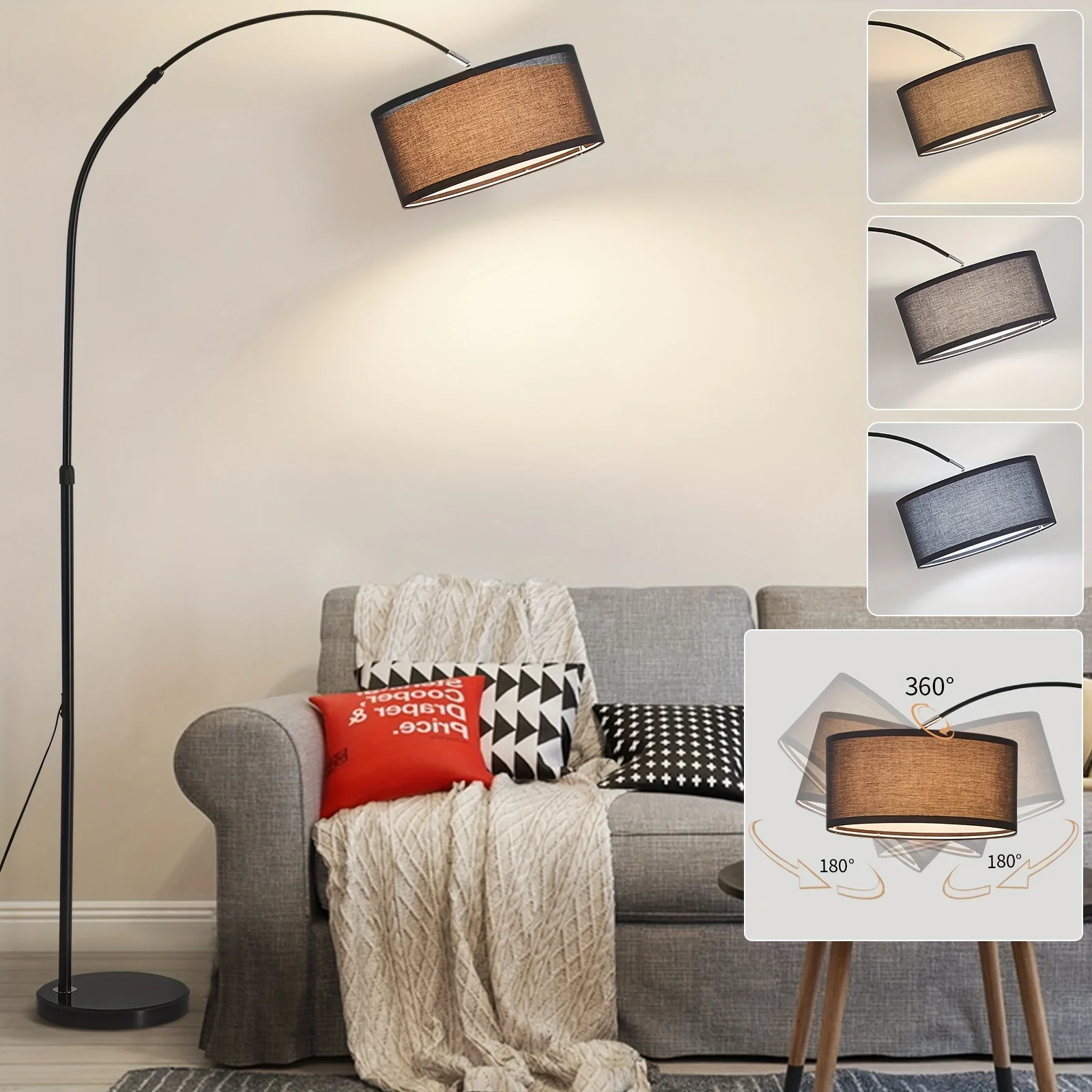
Key Features to Consider When Selecting Arc Lamps for Tall Spaces
Height, Scale and Proportions
When selecting an arc lamp for a high-ceiling room, the height and overall scale of the fixture are critical factors that determine both its visual impact and functional effectiveness. The lamp must be proportional to the room’s dimensions to avoid appearing dwarfed by the surrounding space.
Use these general guidelines to match lamp height to ceiling height:
- For 9-10 foot ceilings: Select arc lamps 60-70 inches (5-6 feet) tall
- For 11-12 foot ceilings: Look for lamps 70-85 inches (6-7 feet) tall
- For 12+ foot ceilings: Choose “extra tall” models 80+ inches (6.5+ feet) tall
Remember that proper ceiling height considerations for arc lamps extend beyond just the lamp’s maximum height. You should maintain at least 12 inches of clearance between the top of the lamp and the ceiling to preserve visual breathing room and prevent the fixture from appearing cramped.
The lamp’s visual weight—its perceived mass and presence—should also be proportionate to the room’s scale. Larger rooms with higher ceilings require lamps with more substantial bases and broader arcs to maintain proper balance. A delicate, slim lamp that looks perfect in a standard-height room might appear insubstantial and lost in a space with soaring ceilings.
Arc Length and Reach
The horizontal reach of an arc lamp determines how far its light extends into the room and over your functional spaces. This dimension is especially important in large rooms with high ceilings, where furniture is often arranged away from walls.
When evaluating arc length:
- Consider the distance from where the lamp base will stand to where light is needed
- Allow for at least 24-30 inches of arc extension over seating or activity areas
- Ensure the arc height provides adequate clearance for people walking underneath
- Match the arc’s scale to room size—larger rooms generally require longer arcs
Oversized arched floor lamps with extended reach are particularly effective in spacious rooms with high ceilings. Their dramatic silhouette helps fill vertical space while projecting light exactly where needed, often extending 40-60 inches from the base to illuminate central seating areas or tables positioned away from walls.
Light Output and Illumination Quality
In rooms with high ceilings, light output becomes increasingly important as illumination must travel farther to effectively brighten the space. Standard lamps often prove inadequate in these grand environments.
Look for these illumination features when selecting an arc lamp for tall spaces:
- Higher lumen output—aim for at least 800-1000 lumens for reading areas and 1200+ lumens for general ambient lighting in high-ceiling rooms
- LED bulbs that provide ample brightness while remaining energy-efficient
- Multiple light sources or adjustable heads for broader light distribution
- Dimmable functionality to customize brightness levels for different activities and times of day
Dimmable arc floor lamps offer valuable versatility in high-ceiling spaces, allowing you to transition from bright task lighting to softer ambient illumination. This adaptability makes them suitable for both practical activities and creating atmosphere, an important consideration in rooms where a single lighting source often needs to serve multiple purposes.
Stability and Base Design
The dramatic curve of an arc lamp creates physics challenges that require careful engineering. As the light fixture extends outward, it creates leverage that must be counterbalanced by a properly weighted base to prevent tipping.
Critical stability factors include:
- Base weight proportional to arc length—longer arcs require heavier bases
- Low center of gravity in the base design for maximum stability
- Non-slip base materials or pads to prevent sliding on smooth floors
- Sufficient base footprint (typically 10-15 inches in diameter) to distribute weight effectively
Marble base arc floor lamps provide exceptional stability through their natural weight while adding luxury and sophisticated style. These substantial bases ensure the lamp remains firmly planted even with extended arcs, an important safety consideration in any home but particularly in households with children or pets.
When evaluating arc lamps, always consider the interplay between these key features—height, arc length, light output, and stability—to select a fixture that meets both the functional requirements and aesthetic potential of your high-ceiling space.
Optimal Placement Strategies for Maximum Impact
The dramatic impact of an arc lamp in a high-ceiling space depends not just on the fixture itself but significantly on its placement within the room. Strategic positioning enhances both the lamp’s visual presence and its functional effectiveness as a light source.
When determining the ideal location for your arc lamp, consider these placement strategies for different room functions:
- Position arc lamps approximately 2-3 feet behind or beside seating areas, allowing the arc to extend over the functional space
- For reading nooks, place the lamp so its light source hangs 18-24 inches from the side or behind the chair, directing illumination over the shoulder
- In dining areas, position the lamp so its light centers over the table, usually 30-36 inches above the surface
- Use arc lamps to define specific zones within open concept spaces, helping to visually separate functional areas
The lighting for high ceiling rooms with arc lamps creates a visual anchor in expansive spaces. Rather than pushing all furniture against walls (a common mistake in large rooms), use arc lamps to establish interior zones that feel intimate and well-defined despite the soaring ceiling height.
When placing arc lamps, maintain proper clearances and spatial relationships:
- Keep a minimum of 12-18 inches between the lamp base and walls to prevent a crowded appearance
- Ensure at least 6.5-7 feet of clearance beneath the lowest point of the arc for comfortable movement
- Position the lamp where its arc won’t obstruct important sightlines across the room
- Consider traffic patterns to prevent the lamp from becoming an obstacle in pathways
Avoid common placement mistakes such as positioning the lamp too far from where light is needed or placing it where the arc creates awkward visual competition with architectural features like beams or columns. In general, arc lamps work best when they complement the room’s natural flow rather than interrupting it.
In rooms with extremely high ceilings, arc lamps can strategically help reduce the perceived height when desired. By creating a visual horizon line at the arc’s highest point, these lamps can make soaring spaces feel more intimate and human-scaled without sacrificing the grandeur that makes high ceilings so appealing.
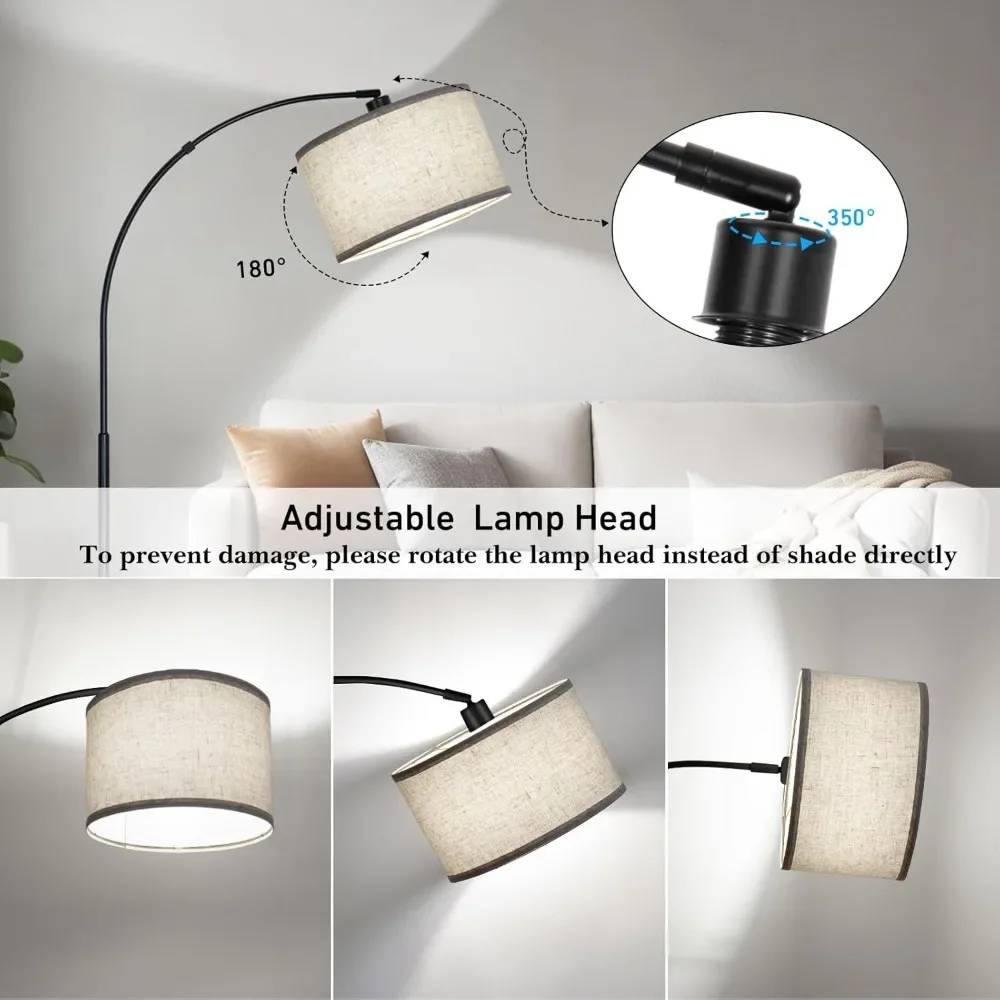
Styling Arc Lamps in Different High-Ceiling Interior Designs
Contemporary and Minimalist Spaces
In sleek contemporary interiors with clean lines and minimalist sensibilities, arc lamps serve as sculptural statements that complement rather than compete with the simplified aesthetic. The sweeping geometric form of an arc lamp adds visual interest without clutter—an important consideration in minimalist design.
For modern high-ceiling spaces:
– Select arc lamps with streamlined profiles and minimal ornamentation
– Choose neutral metallic finishes like brushed nickel, chrome, or matte black
– Look for simple, geometric shade designs that emphasize clean lines
– Position lamps to highlight architectural features rather than distract from them
Contemporary arc floor lamps often feature technological innovations like integrated LED lighting, touch-sensitive controls, and adjustable components that allow customization of light direction and intensity. These modern features align perfectly with the forward-thinking ethos of contemporary design while providing practical lighting solutions for high-ceiling environments.
Industrial and Loft Settings
The raw, unfinished character of industrial spaces and loft settings pairs exceptionally well with the architectural presence of arc lamps. In these environments, the lamp’s exposed mechanical elements become design features rather than aspects to conceal.
To enhance industrial high-ceiling spaces:
– Select arc lamps with visible joints, adjustable mechanisms, and technical details
– Choose materials that highlight industrial character—steel, bronze, iron, and other metal finish arc floor lamps
– Embrace larger scale fixtures that stand up to exposed ductwork, concrete surfaces, and other robust industrial elements
– Look for designs that incorporate industrial motifs like cage shades, exposed bulbs, or articulated arms
In warehouse conversions or spaces with extremely high ceilings (15+ feet), oversized arc lamps with dramatic proportions help humanize the scale while honoring the industrial heritage. Their substantial presence complements the monumental quality of these spaces while bringing light down to human level.
Traditional and Transitional Interiors
Arc lamps—typically considered modern fixtures—can successfully integrate into traditional and transitional interiors when selected with careful attention to finishes, materials, and proportions.
For traditional spaces with high ceilings:
– Choose arc lamps with warm metallic finishes like antique brass, bronze, or gold
– Look for classic shade shapes such as drums or tapered ovals in fabric rather than metal
– Select designs with subtle detailing that references traditional craftsmanship
– Position lamps to complement rather than overwhelm traditional furniture groupings
In transitional interiors that blend traditional comfort with contemporary clean lines, arc lamps serve as perfect bridging elements. Their classic inspiration (derived from 1960s Italian design) combined with modern functionality creates precisely the balance that defines transitional style.
Open Concept and Multi-Use Spaces
In open-plan environments with high ceilings, arc lamps help define functional zones without erecting physical barriers that would compromise the sense of spaciousness.
For multi-functional open spaces:
– Use arc lamps to create visual boundaries between different activity areas
– Position lamps so their illumination pools define specific functional zones
– Select consistent finishes or complementary styles when using multiple arc lamps
– Create lighting layers that can be adjusted as the space transitions between different uses
The styling of oversized arc floor lamps in these expansive environments helps establish rhythm and purpose throughout the space. Their height and reach allow them to define areas without blocking sightlines, maintaining the openness that makes these floor plans desirable while adding necessary structure and illumination.
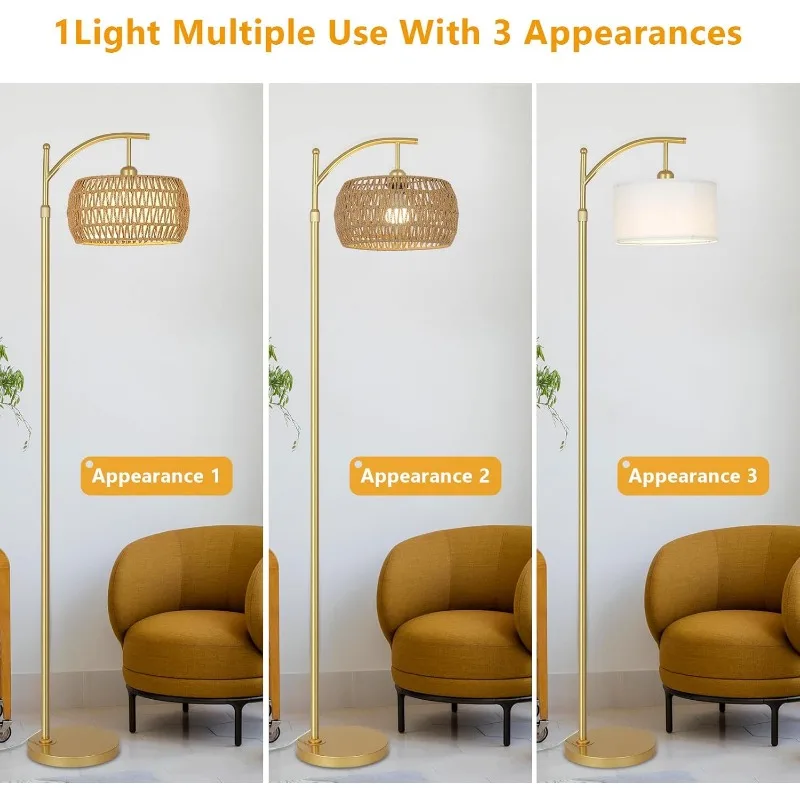
Creating Layered Lighting with Arc Lamps as Focal Points
Effective lighting design for high-ceiling spaces relies on thoughtful layering of different light sources. Arc lamps can serve as centerpieces in these layered plans, providing both functional illumination and visual anchor points that tie the room together.
The concept of layered lighting includes three essential components:
– Ambient lighting provides general illumination throughout the space
– Task lighting focuses on specific activities like reading, dining, or working
– Accent lighting highlights architectural features, artwork, or decorative elements
What makes arc lamps particularly valuable in high-ceiling environments is their ability to fulfill multiple roles simultaneously. A well-positioned arc lamp can provide both focused task lighting over a seating area and contribute to the room’s ambient illumination through the wider dispersion of light from its shade.
Integrating arc lamps with existing lighting elements requires careful consideration of:
– Light distribution patterns to ensure even illumination throughout the space
– Color temperature coordination between different light sources
– Scale relationships between arc lamps and ceiling-mounted fixtures
– Control systems that allow appropriate adjustment of different lighting layers
The best arc lamps for tall ceilings complement rather than compete with architectural lighting. For example, while recessed ceiling lights might provide general illumination from above, arc lamps bring light down to human scale, creating intimacy within the grand volume. Similarly, while chandeliers might serve as dramatic centerpieces, arc lamps extend illumination to the room’s perimeter where ceiling fixtures rarely reach effectively.
For maximum flexibility in high-ceiling spaces, consider adjustable arc floor lamps that allow you to modify light direction and height based on changing needs. These adaptable fixtures can be repositioned to highlight different areas or adjusted to create varying moods, making them valuable components in dynamic lighting designs.
Beyond their practical lighting function, arc lamps help create visual depth in tall spaces by establishing mid-height elements between floor level and ceiling. This vertical layering is particularly important in rooms with high ceilings, where the substantial distance between floor and ceiling can create a sense of disconnection without proper transitional elements.
Adjustable Arc Floor Lamp, Bronze Arc Floor Lamp
Price range: $440.95 through $558.52 Select options This product has multiple variants. The options may be chosen on the product pageBrass Arc Floor Lamp, Contemporary Arc Floor Lamp, LED Arc Floor Lamp
Price range: $490.72 through $522.04 Select options This product has multiple variants. The options may be chosen on the product pageChrome Arc Floor Lamp, LED Arc Floor Lamp
Price range: $304.95 through $1,210.40 Select options This product has multiple variants. The options may be chosen on the product pageContemporary Arc Floor Lamp, Large Arc Floor Lamp, Marble Base Arc Floor Lamp
$224.94 Select options This product has multiple variants. The options may be chosen on the product pageContemporary Arc Floor Lamp, Silver Arc Floor Lamp
$459.99 Select options This product has multiple variants. The options may be chosen on the product pageLED Arc Floor Lamp, Rattan Arc Floor Lamp
$313.58 Select options This product has multiple variants. The options may be chosen on the product page
When incorporating arc lamps within a layered lighting strategy, position them to highlight architectural features like exposed beams, interesting ceiling treatments, or textured walls. Their directional light can emphasize these elements while their physical form provides a visual bridge between the architecture and furnishings.
Comparing Arc Lamps with Other High-Ceiling Lighting Options
When evaluating lighting solutions for spaces with elevated ceilings, it’s valuable to understand how arc lamps compare to other common options. Each lighting type offers distinct advantages and limitations that affect both functionality and aesthetics.
| Lighting Option | Installation Complexity | Flexibility | Initial Cost | Light Distribution | Visual Impact | Best For |
|---|---|---|---|---|---|---|
| Arc Floor Lamps | None – simply place | High – easily repositioned | Moderate | Directed downward with some ambient spread | Strong sculptural presence | Renters, flexible layouts, immediate solutions |
| Chandeliers | Complex – requires ceiling wiring | Fixed once installed | High | Radiates from central point | Dramatic focal point | Formal spaces, central lighting needs |
| Recessed Lighting | Very complex – requires ceiling access | Fixed once installed | High (multiple units) | Even downward illumination | Minimal visual presence | Clean, modern aesthetics |
| Track Lighting | Moderately complex | Adjustable direction | Moderate | Directional spotlighting | Contemporary technical look | Highlighting artwork or features |
| Standard Floor Lamps | None – simply place | High – easily repositioned | Low to moderate | Limited upward reach | Minimal vertical impact | Supplementary lighting, lower ceilings |
| Wall Sconces | Moderate – requires wall wiring | Fixed once installed | Moderate | Upward/downward wall washing | Architectural accent | Highlighting wall textures, corridors |
Arc lamps offer several distinct advantages for high-ceiling applications:
Unlike fixed ceiling fixtures, arc lamps require no electrical installation, making them ideal for rental properties or spaces where ceiling access is difficult. Their freestanding nature allows immediate implementation and flexibility to change with evolving room layouts—a significant advantage over permanently installed lighting.
The long arm arc lamps for open ceilings provide exceptional reach, allowing light to extend far into the room from a base positioned near walls. This capability addresses one of the major challenges of high-ceiling spaces: bringing light into central areas without ceiling-mounted fixtures.
From a cost perspective, quality arc lamps typically range from $150-$600, making them considerably more affordable than professional installation of ceiling fixtures, which can easily exceed $1,000 when accounting for both fixture costs and electrical work. This economic advantage makes arc lamps particularly attractive as either primary lighting solutions or as supplements to existing ceiling fixtures.
However, arc lamps do have limitations compared to installed lighting:
– They occupy floor space that built-in lighting doesn’t require
– They generally provide more focused light rather than whole-room illumination
– Their presence as physical objects may not suit extremely minimalist designs
In many high-ceiling environments, the optimal approach combines arc lamps with complementary lighting types. For example, recessed lighting might provide general illumination while strategically placed arc lamps create focused lighting zones and visual interest at the mid-height level.
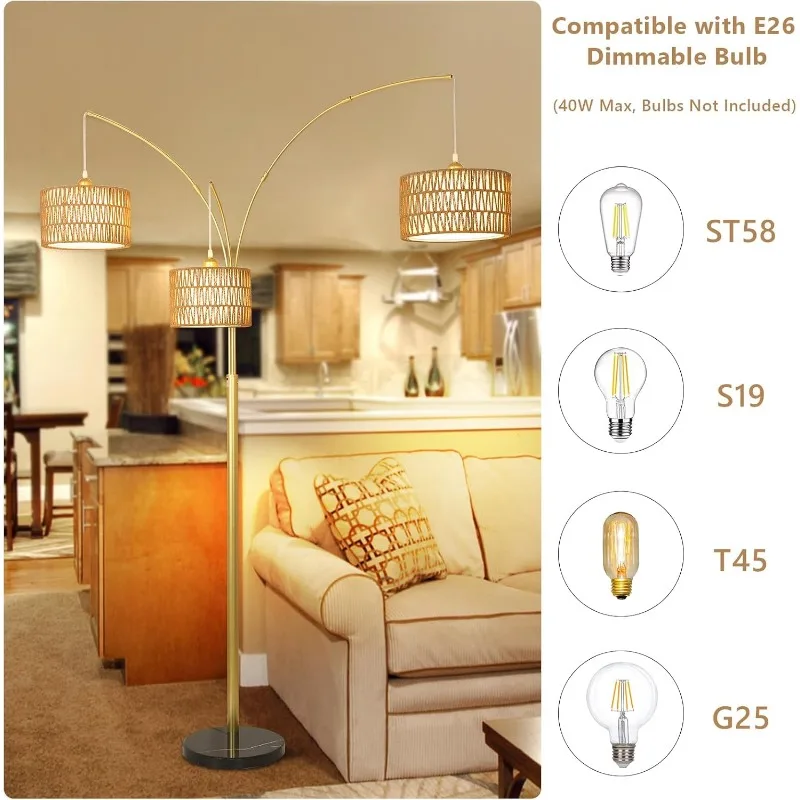
Practical Considerations: Maintenance and Functionality
Beyond their aesthetic appeal and illumination capabilities, arc lamps present practical considerations that impact everyday use in high-ceiling spaces. Understanding these functional aspects ensures your lamp remains a convenient and effective lighting solution for years to come.
Day-to-day operation should be straightforward despite the lamp’s height. Look for these user-friendly features:
– Foot switches that eliminate the need to reach under shades
– In-line cord switches positioned at accessible heights
– Remote control options for easy adjustment without standing
– Dimmer functionality that allows brightness customization without bulb changes
Adjustability becomes particularly important in dynamic living spaces. Consider how easily the lamp can be modified to suit different activities and needs:
– Height adjustability for different ceiling heights and lighting requirements
– Rotatable arms that allow repositioning of light direction
– Adjustable shades that can redirect light spread as needed
– Flexible neck sections for fine-tuning light placement
Maintenance requirements vary based on materials and design but generally include:
– Dust removal from horizontal surfaces of the arc and shade
– Occasional tightening of adjustment knobs or connectors
– Bulb replacement—increasingly infrequent with modern LED options
– Base cleaning appropriate to the material (wood, metal, marble)
The tall arc floor lamps for vaulted ceilings often feature extended height that presents unique considerations for stability and safety. Ensure the base is proportionally weighted to prevent tipping, especially in homes with children or pets. Some designs include counterweights in the base specifically engineered for the physics of their extended reach.
Cord management represents another practical concern, particularly in high-ceiling rooms where the lamp may stand away from walls. Consider:
– Cord length sufficient to reach outlets without stretching
– Clear or coordinating cord colors that minimize visual disruption
– Cord covers or channels if the cord must cross traffic areas
– Strategic furniture placement to help conceal cords
Energy efficiency has become increasingly important in lighting selection. Modern LED arc floor lamps offer significant advantages:
– Extended bulb life often exceeding 25,000 hours
– Reduced energy consumption (typically 75% less than incandescent)
– Cooler operation that eliminates heat concerns with high shades
– Consistent light output that doesn’t diminish over time
When investing in quality arc lamps for high-ceiling spaces, expect a useful lifespan of 10-15 years or more with proper care. Higher-end models from reputable manufacturers like those offered by Interior Ivy typically feature more durable materials, superior construction, and better-engineered mechanical components that maintain stability and adjustment capabilities over time.
Answering Common Questions About Arc Lamps for High Ceilings
Can arc lamps provide enough light for very high ceilings (15+ feet)?
Yes, but selection is crucial. For extremely high ceilings, look specifically for arc lamps designed with extended height and enhanced light output. Models featuring multiple bulbs, higher lumen ratings (1500+), or directional shades can effectively illuminate spaces with ceilings of 15 feet or higher. The lamp’s physical presence won’t reach all the way to such ceilings, but its light output can effectively brighten the space when properly positioned.
Do arc lamps work in rooms with ceiling fans?
Arc lamps and ceiling fans can coexist successfully with thoughtful placement. Position the arc lamp so its highest point remains at least 12-18 inches below the fan’s rotating blades. This prevents any visual collision between the two elements and eliminates any potential for the fan’s air movement to cause the lamp to sway. In larger rooms, consider placing the arc lamp in a different activity zone than the fan to maintain both visual and functional separation.
Are arc lamps stable enough for homes with children or pets?
Quality arc lamps from reputable manufacturers are engineered with properly weighted bases that ensure stability. For households with children or active pets, look for models with particularly substantial bases, lower centers of gravity, and no exposed wiring. Some designs include additional safety features like tip-resistance technology and cord housing to prevent pulling. The extra tall arc lamps for vaulted spaces typically feature proportionally heavier bases specifically designed to maintain stability despite their height.
How do I choose between adjustable and fixed-height models?
Consider your specific needs and space characteristics. Adjustable arc lamps offer versatility for changing activities and furniture arrangements, making them ideal for multipurpose rooms or spaces that evolve frequently. Their adaptability also allows fine-tuning for optimal light placement. Fixed-height models, while less flexible, often feature more streamlined designs with fewer mechanical components that could potentially loosen over time. For dedicated reading or dining areas where lighting needs remain consistent, fixed models may provide a more refined aesthetic solution.
What’s the difference between budget and premium arc lamps for high ceilings?
The price difference between budget ($75-150) and premium ($350-600+) arc lamps reflects significant variations in quality and capabilities. Premium models typically offer:
– Higher-grade materials like solid metals instead of plated finishes
– More substantial bases often using marble, solid wood, or weighted steel
– Better engineering with smoother adjustment mechanisms
– Higher-quality electrical components and switches
– Enhanced stability through better balance and weight distribution
– Superior finishes that resist scratching and discoloration
– More sophisticated design with attention to proportion and detail
For high-ceiling applications where the lamp serves as both a functional light source and a significant design element, investing in quality typically delivers better long-term satisfaction and performance.
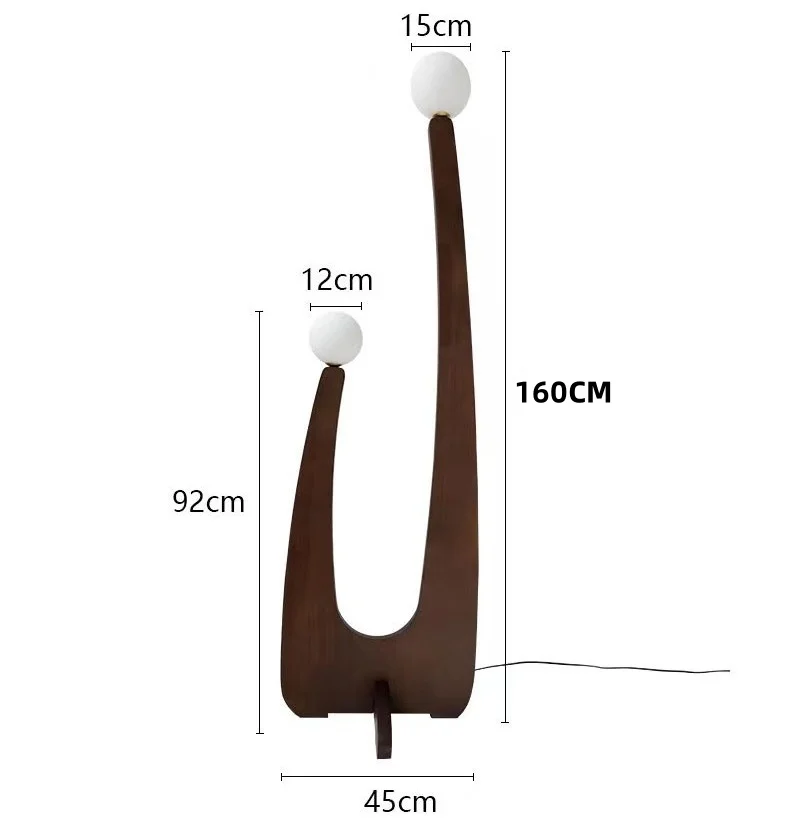
Enhancing Your High-Ceiling Space: Beyond Basic Lighting
Arc lamps contribute far more than illumination to high-ceiling interiors—they serve as architectural elements that help define and enhance the entire space. Their sweeping forms create visual bridges between furniture and ceiling planes, adding crucial mid-level interest in rooms where vertical distance can otherwise feel empty or disconnected.
As sculptural objects, arc lamps create powerful focal points even when not illuminated. Their dramatic silhouettes draw the eye, establishing visual anchors that help ground expansive spaces. This quality makes them particularly valuable in minimalist interiors where fewer objects carry greater design responsibility.
The lighting with oversized arc lamps for tall ceilings helps establish visual rhythm throughout the space. Their curved forms introduce organic movement that softens the angularity often found in high-ceiling architecture, creating a more balanced and harmonious environment.
When integrating arc lamps within your broader interior design:
- Consider wall colors that will either highlight or blend with the lamp’s silhouette—lighter walls make dark lamp frames stand out as dramatic statements, while color-coordinated walls create a more cohesive, subtle integration
- Position furniture to create clear purpose zones beneath and around the arc lamp’s illumination pool
- Incorporate complementary curved elements (rounded furniture, circular rugs, curved artwork) that echo the lamp’s graceful arc
- Use the lamp’s metallic finishes as cues for hardware and accessory selections throughout the space
The vertical presence of arc lamps makes them particularly effective for visually unifying multi-level spaces like:
– Split-level living areas where the lamp can bridge between height transitions
– Lofted spaces where the arc visually connects the upper and lower levels
– Rooms with partial height walls or railings where the lamp rises above the dividers
Understanding the ultimate guide to arc floor lamp bases can help you select a model that not only provides stability but also serves as a design element in its own right. Marble bases add luxury, wooden bases bring warmth, and metallic bases enhance contemporary appeal—each contributing differently to your overall design scheme.
Beyond their practical and aesthetic roles, thoughtfully selected arc lamps contribute to the emotional impact of high-ceiling spaces. Their ability to bring light down to human scale creates intimacy within grandeur—transforming what might be intimidating volume into welcoming, well-proportioned environments that feel both impressive and comfortable.
By addressing both the functional lighting requirements and the design potential of high-ceiling spaces, arc lamps prove themselves to be not merely lighting fixtures but essential architectural elements that enhance the full three-dimensional experience of these dramatic interiors.

